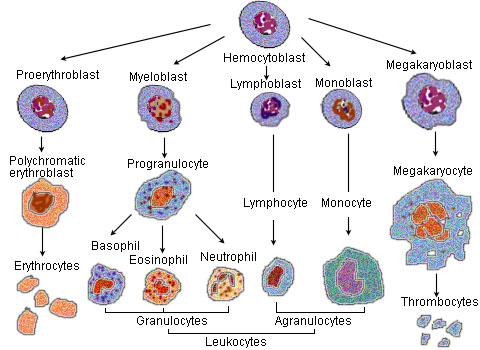Agranulocyte
Agranulocytes are a category of white blood cells that lack visible granules in their cytoplasm. The primary types of agranulocytes are monocytes and lymphocytes.

Definition[edit | edit source]
The term agranulocyte is derived from the prefix "a-" meaning "without" and the word "granule". Thus, agranulocytes are white blood cells without distinguishable granules in their cytoplasm when observed under a microscope. This differentiates them from granulocytes, which possess such granules.
Types[edit | edit source]
Agranulocytes can be primarily classified into two types:
- Monocytes: These cells are the largest type of white blood cell and play a vital role in fighting off certain types of infections, especially those caused by bacteria. They are also responsible for removing dead or damaged cells and helping with the immune response.
- Lymphocytes: Lymphocytes are critical for the body's immune response. They are responsible for producing antibodies and can directly attack cells or help control the immune response. They can be further sub-divided into T-cells and B-cells based on their functions.
Functions[edit | edit source]
Agranulocytes have a range of functions that contribute to the body's immune system:
- Response to Pathogens: Agranulocytes are essential for identifying and targeting various pathogens, including viruses, bacteria, and other harmful agents.
- Cellular Clean-up: Particularly monocytes can differentiate into macrophages which engulf and digest cellular debris and pathogens.
- Immunity Memory: Lymphocytes play a significant role in the adaptive immune system by remembering specific pathogens, ensuring faster and more efficient responses during future encounters.
Importance in Health and Disease[edit | edit source]
A balanced number of agranulocytes is essential for maintaining health and ensuring the effective functioning of the immune system. An abnormal count can indicate various conditions:
- An increase in lymphocytes might be seen in viral infections, certain types of leukemia, or lymphoma.
- A decrease in lymphocytes might indicate conditions like HIV/AIDS, severe malnutrition, or the effect of certain medications.
See Also[edit | edit source]
| Agranulocyte Resources | ||
|---|---|---|
|
| |
Navigation: Wellness - Encyclopedia - Health topics - Disease Index - Drugs - World Directory - Gray's Anatomy - Keto diet - Recipes
Search WikiMD
Ad.Tired of being Overweight? Try W8MD's physician weight loss program.
Semaglutide (Ozempic / Wegovy and Tirzepatide (Mounjaro / Zepbound) available.
Advertise on WikiMD
WikiMD is not a substitute for professional medical advice. See full disclaimer.
Credits:Most images are courtesy of Wikimedia commons, and templates Wikipedia, licensed under CC BY SA or similar.Contributors: Prab R. Tumpati, MD


